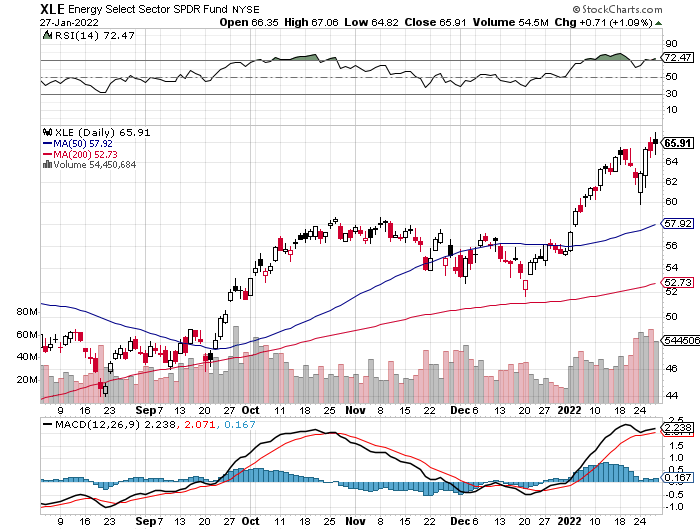Green energy may be the future, but it’s still having a rough time in the present while shares of conventional fossil fuel companies extend last year’s strong bull run.
The sharp divergence for old vs. new energy stocks remains conspicuous year to date, based on a set of ETFs through yesterday’s close (Jan. 27). Energy Select SPDR (XLE), which holds the likes of Exxon Mobil, Chevron and other old-line energy stocks, ticked up on Thursday to its highest level since 2014.

In sharp contrast, various slices of clean-energy industries are extending 2021’s losses this year. For example, Invesco WilderHill Clean Energy ETF (PBW) yesterday fell to its lowest price in well over a year.

Clean energy remains a dirty word from an investment perspective in the new year, and PBW’s hardly alone among ETFs in this space in taking a drubbing from Mr. Market. Several flavors of so-called new energy companies are still on the defensive, including Invesco Solar ETF (TAN), VanEck Vectors Low Carbon Energy ETF (SMOG), and iShares Global Clean Energy ETF (ICLN) — all of which have lost ground so far in 2022.

Meanwhile, XLE’s rally this year has been accompanied by year-to-date gains in SPDR S&P Oil & Gas Equipment & Services ETF (XES), SPDR S&P Oil & Gas Exploration & Production ETF (XOP) and Invesco S&P SmallCap Energy ETF (PSCE).
No one should write off clean energy’s longer-term prospects, or assume that old energy’s relative strength will remain a permanent feature. Indeed, some analysts are eyeing the losses in the former as buying opportunities. But for now, it’s premature to reliably declare an end to the recent downside momentum in green energy shares.
Note, too, that a combination of geopolitical risks and a recovering global economy are propping up prices in the fossil-fuel stocks. An added complication is that the world’s transition to cleaner fuels is hampered by a lack of rising supply to match increased energy demand. As two authorities on energy policy explain:
Global investment in oil and gas is now at record lows as a result of uncertainty about the outlook for demand in a world more serious about climate and the terrible financial performance of the oil sector over the past decade.
This low level of oil and gas investment would be welcome if it were because demand was falling or investment in clean energy was rising at a rate to offset the fall in investment. But oil and gas use are both rising and projected to continue doing so for years. Investment in clean energy is rising, too, but not nearly at the rate to meet the growth in energy demand, not to mention the world’s climate goals.
Meanwhile, the current trends in energy will, at some point, go too far. Perhaps in the not-so-distant future, old energy will plateau and reverse while battered green energy shares will become unusually attractive on an ex ante basis and start to recover. We’re not there yet, but it’s only a matter of when not if.
Learn To Use R For Portfolio Analysis
Quantitative Investment Portfolio Analytics In R:
An Introduction To R For Modeling Portfolio Risk and Return
By James Picerno